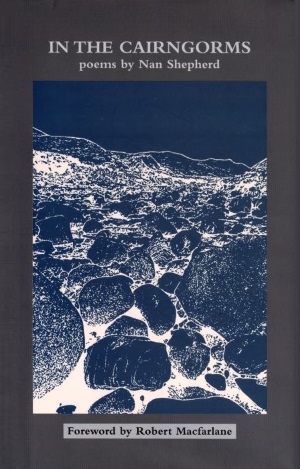
Nan Shepherd, Poet and Novelist
The morning: The Living Mountain; the afternoon: In The Cairngorms, now republished by Galileo Publishers, Cambridge, and with an introduction by Robert Macfarlane.
Nan Shepherd spent eternities walking in the Cairngorms and came to associate herself with this wild stump of a trillion ton mass of Devonina era magma.
Of our handful of great modernist writers in Scotland Anna (Nan) Shepherd is in the first rank
Similarly Nan Shepherd was a voracious intellectual and the commonplace books she kept from the age of 14 reveal the enormous breadth of her reading, which was poetic, historical, philosophical and religious.
Nan Shepherd's greatest artistic burst can be dated to between 1928 and 1933, during which time she published the three novels she is best known for today. These three novels are fittingly modernist, and are The Quarry Wood, The Weatherhouse and A Pass in the Grampians, although The Living Mountain, written in the last years of Word War 2 is possibly a superior work.
The book in question, In the Cairngorms was published at the close of this intense burst of literary activity, in 1934, and from that point Nan Shepherd stopped publishing for almost 45 years, although this period also includes The Living Mountain (which is around 30,000 words) and her occasional articles.
Reading the correspondence between Neil Gunn and Nan Shepherd regarding The Living Mountain offers a sense of how difficult the writing life can sometimes be. It isn't clear whether Nan Shepherd was unable or unwilling to find a publisher for The Living Mountain, but Gunn advised her at the time of writing that it might be 'difficult, perhaps' to get it published, due in part he says to the 'proper nouns' referring to places in the Cairngorms.
Depressingly, Gunn suggested that Nan Shepherd append maps, or even photographs in trying to make her book a better prospect, and he warns her against Faber (who are 'in a mess' he says) and suggests that The Living Mountain be serialised in Scots Magazine. Ach, a fate worse than death!
The Living Mountain was eventually published with no fanfares by Aberdeen University Press in 1977, and it was quietly received. But The Living Mountain probably deserves more, and it's a shame that Gunn didn't see its magic, its detailed collision of prose and poetry, and its frank disobedience as a literary artifact.
The Living Mountain is difficult to describe, but the best efforts have been made by Robert Macfarlane, who is the editor of the present volume. The Living Mountain is, he says, 'A celebratory prose poem? A geo-poetic quest? A philosophical enquiry into the nature of knowledge? A metaphysical mashup of Presbyterianism and Tao?"
The Living Mountain is a parochial work, and much as it is loved by habitues of the mountains themselves, and Deesiders and others in the know, it has little repute south of The Mearns.
We can factor in Nan Shepherd's personal and until now little-observed life, a woman not only in the male-dominated world of mountaineering, but a woman in the male dominated world of literature. In this much, The Living Mountain perhaps like Nan Shepherd herself, have slipped into the cracks and crevices left upon the landscape by the ton weight of passing dinosaurs like MacDiarmid, and Neil Gunn himself.
Nan Shepherd's stone slab outside the Writers' Museum in Edinburgh:

Curious, but not the only place around literary Edinburgh where 'leave(s)' and 'live' combine ...